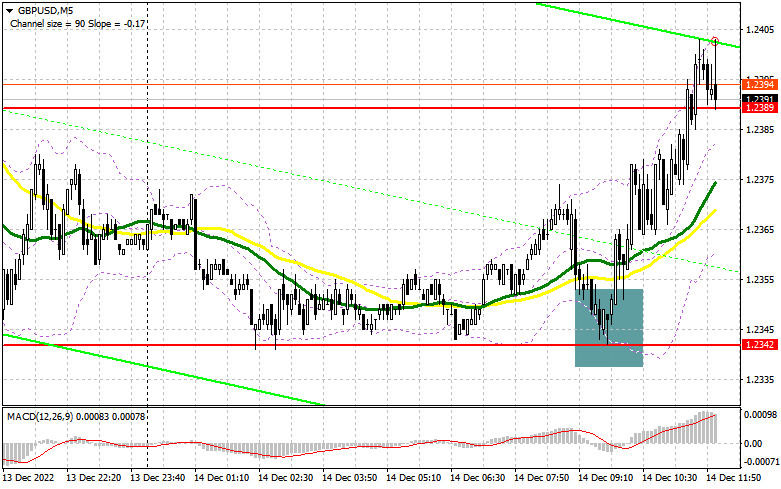
In my morning review, I mentioned the level of 1.2342 and recommended entering the market from there. Let's see what happened on the 5-minute chart. A decline to this level and its false breakout that was caused by positive inflation news in the UK allowed traders to add more long positions in line with the ongoing uptrend. As a result, the pair went up by almost 60 pips to trade above 1.2389. The technical outlook for the second half of the day has not changed.

For long positions on GBP/USD:
A lot will depend on the Fed's decision and its outlook for the next year. Positive forecasts may play on the side of the British pound, given that yesterday's inflation data in the US showed that prices slowed more than expected. The best moment to buy the pound will be when the price settles firmly above the level of 1.2389. A downward retest and a false breakout at this level closer to the Fed's meeting will create a good entry point for going long, keeping in mind a further advance to the monthly high of 1.2439. A breakout of the range and its downward retest after the Fed's meeting will allow the bulls to spread their wings. If so, a new buy signal will be formed with the target at the recent high of 1.2484. The level of 1.2516 will serve as the highest target where I recommend profit taking. If bulls fail to push the price above the 1.2389 level in the second half of the day, the pair will come under more pressure ahead of Jerome Powell's speech. In this case, it is better to buy the pair only at the level of 1.2342 after its false breakout. This is the level where the moving averages support the bulls. Going long on GBP/USD right after a rebound is recommended from 1.2295 or 1.2248, considering an intraday correction of 30-35 pips.
For short positions on GBP/USD:
Meanwhile, bears are staying aside, making no attempt to change the situation. If the pound returns below 1.2389 in the afternoon trade, traders should open short positions. At the same time, we should keep in mind that the Fed is going to revise its monetary policy towards dovish. Therefore, those of you who will follow this signal shroud set stop-loss orders. When moving lower, the price may test the level of 1.2342 where bulls may step in. Only a false breakout of this level and its downward retest during Powell's speech will give an additional sell signal and pause the bullish trend. If so, the price may head for the 1.2295 level. At this point, bears my face an obstacle. A breakout and an upward retest of this level will pave the way to the furthest target at 1.2248 where I recommend profit taking. If bears fail to develop a strong downtrend from the level of 1.2439, bulls will use this opportunity to break above the monthly highs. This will allow the price to jump to 1.2484. Its fall breakout will create a good entry point into short positions with more targets below. If bears show no activity at this level, it would be wise to sell GBP/USD immediately after a rebound from 1.2516, bearing in mind a possible intraday correction of 30-35 pips.

COT report
The Commitments of Traders (COT) report for December 6 showed a rise in long positions and a drop in the short ones. Apparently, the pound buyers expect it to rise further given that the monetary policy of the US Fed is getting less aggressive. Besides, the Bank of England has managed to catch up with the interest rate set by the Fed. At the same time, the recent data on business activity in the UK signals that the country has entered a recession although its scope is smaller than economists had predicted. The fresh GDP report has exceeded expectations. However, it had been contracting for the three previous months which is another proof that the recession is here. The Bank of England is determined to tackle inflation further and raise borrowing costs which means that the UK economy has more hurdles ahead. Therefore, it is hardly surprising that traders do not rush to buy the pair although they still do so in the short-term perspective. According to the latest COT report, short positions of the non-commercial group of traders declined by 5,852 to 56,732, while long positions went up by 2,539 to 28,539. This led to a decrease in the negative value of the total non-commercial net position to -28,193 from -36 584. The weekly closing price increased to 1.2149 from 1.1958 a week ago.
Indicator signals:
Moving Averages
Trading above the 30- and 50-day moving averages indicates that bulls still prevail.
Please note that the time period and levels of the moving averages are analyzed only for the H1 chart, which differs from the general definition of the classic daily moving averages on the D1 chart.
Bollinger Bands
In case of a decline, the lower band of the indicator at 1.2342 will serve as support.
Description of indicators:
• A moving average of a 50-day period determines the current trend by smoothing volatility and noise; marked in yellow on the chart;
• A moving average of a 30-day period determines the current trend by smoothing volatility and noise; marked in green on the chart;
• MACD Indicator (Moving Average Convergence/Divergence) Fast EMA with a 12-day period; Slow EMA with a 26-day period. SMA with a 9-day period;
• Bollinger Bands: 20-day period;
• Non-commercial traders are speculators such as individual traders, hedge funds, and large institutions who use the futures market for speculative purposes and meet certain requirements;
• Long non-commercial positions represent the total number of long positions opened by non-commercial traders;
• Short non-commercial positions represent the total number of short positions opened by non-commercial traders;
• The non-commercial net position is the difference between short and long positions of non-commercial traders